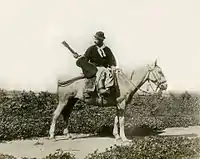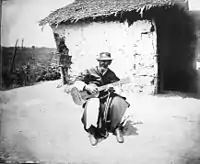Payada
The payada is a folk music tradition native to Argentina, Uruguay, southern Brasil, and south Paraguay as part of the Gaucho culture and literature. In Chile it is called paya and performed by huasos. It is a performance of improvised ten-line verse called décimas usually accompanied by guitar. The performer is called a "payador", albeit any guitar performer in the region is called by the same name. In performances of two or more payadores (the "payada"), known as contrapunto, they will compete to produce the most eloquent verse, each answering questions posed by the other, often insulting. The durations of these verse duels can be exceedingly long, often many hours, and they end when one payador fails to respond immediately to his opponent.[1] Musical styles often used in the payada are the cifra, the huella and the milonga. [2]



History
The work of Bartolomé Hidalgo (born in Montevideo in 1788) is considered a precedent of this form of art in the Río de la Plata. Hidalgo is regarded as the first gaucho poet. His birthdate, August 24, was established as the "Day of the Payador" in Uruguay.[3][4]
In Argentina, July 23 was established as the "Day of the Payador" in commemoration of the famous payada where Juan de Nava and Gabino Ezeiza contended. This payada was held in Paysandú in 1884, and Ezeiza was proclaimed the winner with the improvisation of his famous Saludo a Paysandú. A recording of this song is the only existing record of Ezeiza's voice.[5]
The first registered payador was Simón Méndez (nicknamed Guasquita), a soldier who fought in the British invasions of the River Plate.[6] Both in Argentina and Uruguay, the payada is considered part of the "gauchesca" culture. Santos Vega (to whom writer Rafael Obligado dedicated his most famous poem) is considered "the" payador par excellence, with successors such as Gabino Ezeiza, José Betinoti, Carlos Molina, Abel Soria, Julio Gallego, Gabino Sosa Benítez, Cayetano Daglio, among others.
The payada has also been parodied by the comedy-musical group Les Luthiers in their Payada de la vaca.[7]
The work of Bartolomé Hidalgo, born in Montevideo in 1788, who is considered the first gaucho poet, can be found as an antecedent to the appearance of this art in the Río de la Plata. The date of his birth (August 24) was established by law as "Payador's Day" in Uruguay.[8][9]
References
- R.Fernández Manzano y otros: El trovo de la Alpujarra. Ed. Centro de Documentación Musical de Andalucía, 1992, pág. 27
- The Garland Handbook of Latin American Music, Volume 1 By Dale Alan Olsen, Daniel Edward Sheeh p. 398
- Uruguayan Law 16.764
- "Especial del Día del Payador" on Chasque.net
- "Saludo a Paysandú" by Gabino Ezeiza
- "La payada, un arte que cautiva y sorprende" Archived 2015-06-23 at the Wayback Machine, La Nación (Buenos Aires), 20 Mar 1999
- Payada de la vaca on Les Luthiers official web
- "archive.ph". archive.ph. Archived from the original on 2007-09-22. Retrieved 2022-11-08.
{{cite web}}: CS1 maint: bot: original URL status unknown (link) - "vecinet - No. 627 - especial día del payador". www.chasque.net. Retrieved 2022-11-08.
External links
 Media related to Payada at Wikimedia Commons
Media related to Payada at Wikimedia Commons